您好,登錄后才能下訂單哦!
您好,登錄后才能下訂單哦!
這篇文章將為大家詳細講解有關Hadoop中MapReduce常用算法有哪些,小編覺得挺實用的,因此分享給大家做個參考,希望大家閱讀完這篇文章后可以有所收獲。
hadoop fs -mkdir /import
創建一個或者多個文本,上傳
hadoop fs -put test.txt /import/
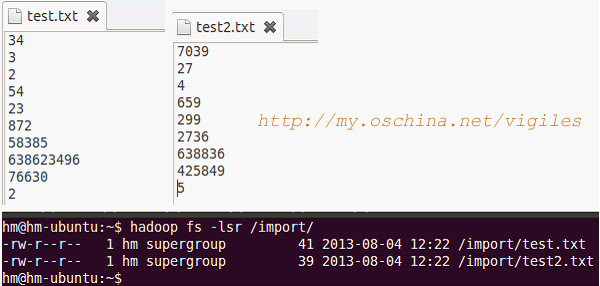
package com.cuiweiyou.sort;
import java.io.IOException;
import org.apache.hadoop.conf.Configuration;
import org.apache.hadoop.fs.Path;
import org.apache.hadoop.io.LongWritable;
import org.apache.hadoop.io.NullWritable;
import org.apache.hadoop.io.Text;
import org.apache.hadoop.mapreduce.Job;
import org.apache.hadoop.mapreduce.Mapper;
import org.apache.hadoop.mapreduce.Reducer;
import org.apache.hadoop.mapreduce.lib.input.FileInputFormat;
import org.apache.hadoop.mapreduce.lib.output.FileOutputFormat;
//hadoop默認排序:
//如果k2、v2類型是Text-文本,結果是按照字典順序
//如果k2、v2類型是LongWritable-數字,結果是按照數字大小順序
public class SortTest {
/**
* 內部類:映射器 Mapper<KEY_IN, VALUE_IN, KEY_OUT, VALUE_OUT>
*/
public static class MyMapper extends Mapper<LongWritable, Text, LongWritable, NullWritable> {
/**
* 重寫map方法
*/
public void map(LongWritable k1, Text v1, Context context) throws IOException, InterruptedException {
//這里v1轉為k2-數字類型,舍棄k1。null為v2
context.write(new LongWritable(Long.parseLong(v1.toString())), NullWritable.get());
//因為v1可能重復,這時,k2也是可能有重復的
}
}
/**
* 內部類:拆分器 Reducer<KEY_IN, VALUE_IN, KEY_OUT, VALUE_OUT>
*/
public static class MyReducer extends Reducer<LongWritable, NullWritable, LongWritable, NullWritable> {
/**
* 重寫reduce方法
* 在此方法執行前,有個shuffle過程,會根據k2將對應的v2歸并為v2[...]
*/
protected void reduce(LongWritable k2, Iterable<NullWritable> v2, Reducer<LongWritable, Context context) throws IOException, InterruptedException {
//k2=>k3, v2[...]舍棄。null => v3
context.write(k2, NullWritable.get());
//此時,k3如果發生重復,根據默認算法會發生覆蓋,即最終僅保存一個k3
}
}
public static void main(String[] args) throws Exception {
// 聲明配置信息
Configuration conf = new Configuration();
conf.set("fs.default.name", "hdfs://localhost:9000");
// 創建作業
Job job = new Job(conf, "SortTest");
job.setJarByClass(SortTest.class);
// 設置mr
job.setMapperClass(MyMapper.class);
job.setReducerClass(MyReducer.class);
// 設置輸出類型,和Context上下文對象write的參數類型一致
job.setOutputKeyClass(LongWritable.class);
job.setOutputValueClass(NullWritable.class);
// 設置輸入輸出路徑
FileInputFormat.setInputPaths(job, new Path("/import/"));
FileOutputFormat.setOutputPath(job, new Path("/out"));
// 執行
System.exit(job.waitForCompletion(true) ? 0 : 1);
}
}
可以看到,不僅排序而且去重了。
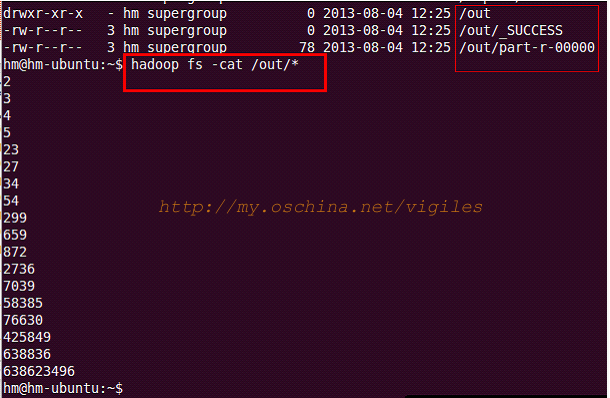
需求:查取手機號有哪些。這里的思路和上面排序算法的思路是一致的,僅僅多了分割出手機號這一步驟。
創建兩個文本,手動輸入一些測試內容。每個字段用制表符隔開。日期,電話,地址,方式,數據量。
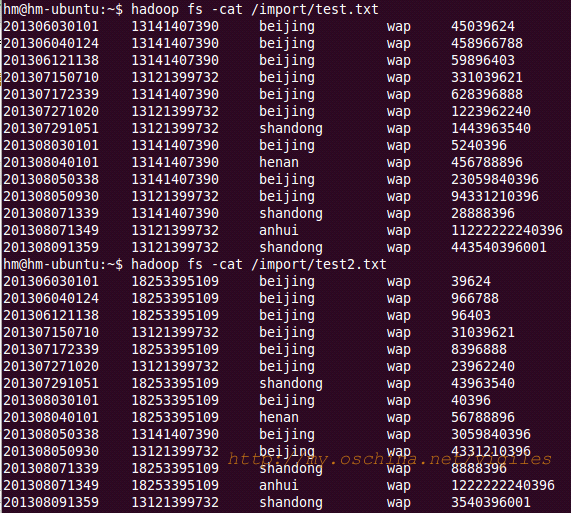
/**
* 映射器 Mapper<KEY_IN, VALUE_IN, KEY_OUT, VALUE_OUT>
*/
public static class MyMapper extends Mapper<LongWritable, Text, Text, NullWritable> {
/**
* 重寫map方法
*/
protected void map(LongWritable k1, Text v1, Context context) throws IOException ,InterruptedException {
//按照制表符進行分割
String[] tels = v1.toString().split("\t");
//k1 => k2-第2列手機號,null => v2
context.write(new Text(tels[1]), NullWritable.get());
}
}
/************************************************************
* 在map后,reduce前,有個shuffle過程,會根據k2將對應的v2歸并為v2[...]
***********************************************************/
/**
* 拆分器 Reducer<KEY_IN, VALUE_IN, KEY_OUT, VALUE_OUT>
*/
public static class MyReducer extends Reducer<Text, NullWritable, Text, NullWritable> {
/**
* 重寫reduce方法
*/
protected void reduce(Text k2, Iterable<NullWritable> v2, Context context) throws IOException ,InterruptedException {
//此時,k3如果發生重復,根據默認算法會發生覆蓋,即最終僅保存一個k3,達到去重到效果
context.write(k2, NullWritable.get());
}
}
// 設置輸出類型,和Context上下文對象write的參數類型一致 job.setOutputKeyClass(Text.class); job.setOutputValueClass(NullWritable.class);

需求:查詢在北京地區發生的上網記錄。思路同上,當寫出 k2 、 v2 時加一個判斷即可。
同上。
/**
* 內部類:映射器 Mapper<KEY_IN, VALUE_IN, KEY_OUT, VALUE_OUT>
*/
public static class MyMapper extends Mapper<LongWritable, Text, Text, NullWritable> {
/**
* 重寫map方法
*/
protected void map(LongWritable k1, Text v1, Context context) throws IOException ,InterruptedException {
//按照制表符進行分割
final String[] adds = v1.toString().split("\t");
//地址在第3列
//k1 => k2-地址,null => v2
if(adds[2].equals("beijing")){
context.write(new Text(v1.toString()), NullWritable.get());
}
}
}
/**
* 內部類:拆分器 Reducer<KEY_IN, VALUE_IN, KEY_OUT, VALUE_OUT>
*/
public static class MyReducer extends Reducer<Text, NullWritable, Text, NullWritable> {
/**
* 重寫reduce方法
*/
protected void reduce(Text k2, Iterable<NullWritable> v2, Context context) throws IOException ,InterruptedException {
context.write(k2, NullWritable.get());
}
}
// 設置輸出類型,和Context上下文對象write的參數類型一致 job.setOutputKeyClass(Text.class); job.setOutputValueClass(NullWritable.class);
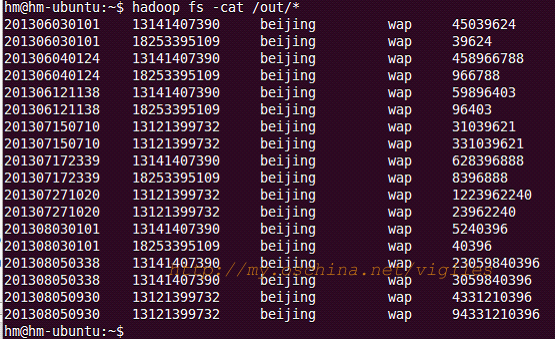
這個算法非常經典,面試必問。實現這個效果的算法也很多。下面是個簡單的示例。
需求:找到流量最大值;找出前5個最大值。
同上。
//map
public static class MyMapper extends Mapper<LongWritable, Text, LongWritable, NullWritable> {
//首先創建一個臨時變量,保存一個可存儲的最小值:Long.MIN_VALUE=-9223372036854775808
long temp = Long.MIN_VALUE;
//找出最大值
protected void map(LongWritable k1, Text v1, Context context) throws IOException ,InterruptedException {
//按照制表符進行分割
final String[] flows = v1.toString().split("\t");
//將文本轉數值
final long val = Long.parseLong(flows[4]);
//如果v1比臨時變量大,則保存v1的值
if(temp<val){
temp = val;
}
}
/** ---此方法在全部的map任務結束后執行一次。這時僅輸出臨時變量到最大值--- **/
protected void cleanup(Context context) throws IOException ,InterruptedException {
context.write(new LongWritable(temp), NullWritable.get());
System.out.println("文件讀取完畢");
}
}
//reduce
public static class MyReducer extends Reducer<LongWritable, NullWritable, LongWritable, NullWritable> {
//臨時變量
Long temp = Long.MIN_VALUE;
//因為一個文件得到一個最大值,再次將這些值比對,得到最大的
protected void reduce(LongWritable k2, Iterable<NullWritable> v2, Context context) throws IOException ,InterruptedException {
long long1 = Long.parseLong(k2.toString());
//如果k2比臨時變量大,則保存k2的值
if(temp<long1){
temp = long1;
}
}
/** !!!此方法在全部的reduce任務結束后執行一次。這時僅輸出臨時變量到最大值!!! **/
protected void cleanup(Context context) throws IOException, InterruptedException {
context.write(new LongWritable(temp), NullWritable.get());
}
}
// 設置輸出類型 job.setOutputKeyClass(LongWritable.class); job.setOutputValueClass(NullWritable.class);

//map
public static class MyMapper extends Mapper<LongWritable, Text, LongWritable, NullWritable> {
//首先創建一個臨時變量,保存一個可存儲的最小值:Long.MIN_VALUE=-9223372036854775808
long temp = Long.MIN_VALUE;
//Top5存儲空間
long[] tops;
/** 次方法在run中調用,在全部map之前執行一次 **/
protected void setup(Context context) {
//初始化數組長度為5
tops = new long[5];
}
//找出最大值
protected void map(LongWritable k1, Text v1, Context context) throws IOException ,InterruptedException {
//按照制表符進行分割
final String[] flows = v1.toString().split("\t");
//將文本轉數值
final long val = Long.parseLong(flows[4]);
//保存在0索引
tops[0] = val;
//排序后最大值在最后一個索引,這樣從后到前依次減小
Arrays.sort(tops);
}
/** ---此方法在全部到map任務結束后執行一次。這時僅輸出臨時變量到最大值--- **/
protected void cleanup(Context context) throws IOException ,InterruptedException {
//保存前5條數據
for( int i = 0; i < tops.length; i++) {
context.write(new LongWritable(tops[i]), NullWritable.get());
}
}
}
//reduce
public static class MyReducer extends Reducer<LongWritable, NullWritable, LongWritable, NullWritable> {
//臨時變量
Long temp = Long.MIN_VALUE;
//Top5存儲空間
long[] tops;
/** 次方法在run中調用,在全部map之前執行一次 **/
protected void setup(Context context) {
//初始化長度為5
tops = new long[5];
}
//因為每個文件都得到5個值,再次將這些值比對,得到最大的
protected void reduce(LongWritable k2, Iterable<NullWritable> v2, Context context) throws IOException ,InterruptedException {
long top = Long.parseLong(k2.toString());
//
tops[0] = top;
//
Arrays.sort(tops);
}
/** ---此方法在全部到reduce任務結束后執行一次。輸出前5個最大值--- **/
protected void cleanup(Context context) throws IOException, InterruptedException {
//保存前5條數據
for( int i = 0; i < tops.length; i++) {
context.write(new LongWritable(tops[i]), NullWritable.get());
}
}
}
// 設置輸出類型 job.setOutputKeyClass(LongWritable.class); job.setOutputValueClass(NullWritable.class);
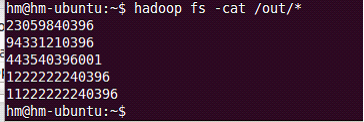
本例中的單表實際就是一個文本文件。

//map
public static class MyMapper extends Mapper<LongWritable, Text, Text, Text> {
//拆分原始數據
protected void map(LongWritable k1, Text v1, Context context) throws IOException ,InterruptedException {
//按制表符拆分記錄
String[] splits = v1.toString().split("\t");
//一條k2v2記錄:把孫輩作為k2;祖輩加下劃線區分,作為v2
context.write(new Text(splits[0]), new Text("_"+splits[1]));
//一條k2v2記錄:把祖輩作為k2;孫輩作為v2。就是把原兩個單詞調換位置保存
context.write(new Text(splits[1]), new Text(splits[0]));
}
/**
張三 _張三爸爸
張三爸爸 張三
張三爸爸 _張三爺爺
張三爺爺 張三爸爸
**/
}
//reduce
public static class MyReducer extends Reducer<Text, Text, Text, Text> {
//拆分k2v2[...]數據
protected void reduce(Text k2, Iterable<Text> v2, Context context) throws IOException ,InterruptedException {
String grandchild = ""; //孫輩
String grandfather = ""; //祖輩
/**
張三爸爸 [_張三爺爺,張三]
**/
//從迭代中遍歷v2[...]
for (Text man : v2) {
String p = man.toString();
//如果單詞是以下劃線開始的
if(p.startsWith("_")){
//從索引1開始截取字符串,保存到祖輩變量
grandfather = p.substring(1);
}
//如果單詞沒有下劃線起始
else{
//直接賦值給孫輩變量
grandchild = p;
}
}
//在得到有效數據的情況下
if( grandchild!="" && grandfather!=""){
//寫出得到的結果。
context.write(new Text(grandchild), new Text(grandfather));
}
/**
k3=張三,v3=張三爺爺
**/
}
}
// 設置輸出類型 job.setOutputKeyClass(Text.class); job.setOutputValueClass(Text.class);

本例中仍簡單采用兩個文本文件。
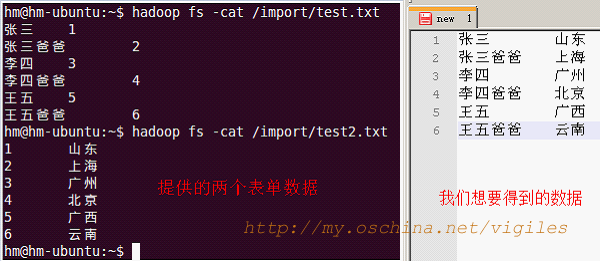
//map
public static class MyMapper extends Mapper<LongWritable, Text, Text, Text> {
//拆分原始數據
protected void map(LongWritable k1, Text v1, Context context) throws IOException ,InterruptedException {
//拆分記錄
String[] splited = v1.toString().split("\t");
//如果第一列是數字(使用正則判斷),就是地址表
if(splited[0].matches("^[-+]?(([0-9]+)([.]([0-9]+))?|([.]([0-9]+))?)$")){
String addreId = splited[0];
String address = splited[1];
//k2,v2-加兩條下劃線作為前綴標識為地址
context.write(new Text(addreId), new Text("__"+address));
}
//否則就是人員表
else{
String personId = splited[1];
String persName = splited[0];
//k2,v2-加兩條橫線作為前綴標識為人員
context.write(new Text(personId), new Text("--"+persName));
}
/**
1 __北京
1 --張三
**/
}
}
//reduce
public static class MyReducer extends Reducer<Text, Text, Text, Text> {
//拆分k2v2[...]數據
protected void reduce(Text k2, Iterable<Text> v2, Context context) throws IOException ,InterruptedException {
String address = ""; //地址
String person = ""; //人員
/**
1, [__北京,--張三]
**/
//迭代的是address或者person
for (Text text : v2) {
String tmp = text.toString();
if(tmp.startsWith("__")){
//如果是__開頭的是address
address = tmp.substring(2); //從索引2開始截取字符串
}
if(tmp.startsWith("--")){
//如果是--開頭的是person
person = tmp.substring(2);
}
}
context.write(new Text(person), new Text(address));
}
/**
k3=張三,v3=北京
**/
// 設置輸出類型 job.setOutputKeyClass(Text.class); job.setOutputValueClass(Text.class);
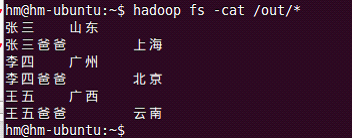
關于“Hadoop中MapReduce常用算法有哪些”這篇文章就分享到這里了,希望以上內容可以對大家有一定的幫助,使各位可以學到更多知識,如果覺得文章不錯,請把它分享出去讓更多的人看到。
免責聲明:本站發布的內容(圖片、視頻和文字)以原創、轉載和分享為主,文章觀點不代表本網站立場,如果涉及侵權請聯系站長郵箱:is@yisu.com進行舉報,并提供相關證據,一經查實,將立刻刪除涉嫌侵權內容。